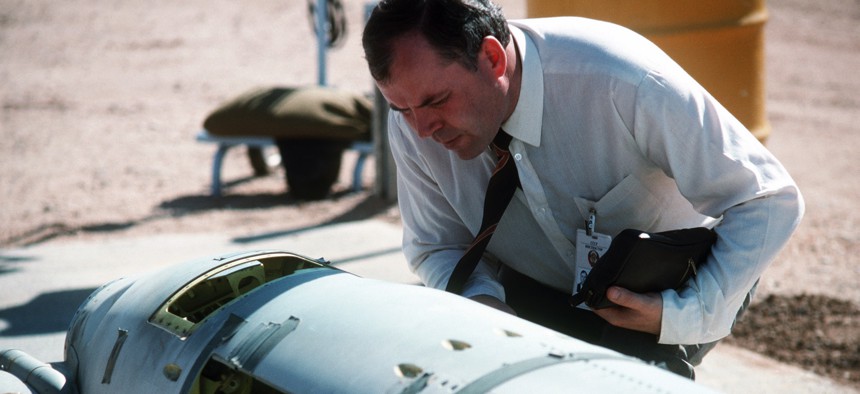
A Soviet inspector examines a BGM-109G Tomahawk ground launched cruise missile (GLCM) before its destruction in 1988. DOD / Jose Lopez
Don’t Let On-Site Inspections Go Extinct
In-person visits to foreign military bases and weapons facilities improve national security in more ways than meet the eye.
The authors of this piece are part of a dwindling breed who have carried out and overseen arms control treaty on-site inspections. If the New Strategic Arms Reduction Treaty, or New START, isn’t extended by Presidents Donald Trump and Vladimir Putin, then our breed could become extinct. U.S. national security would also be weakened, and prospects for strategic arms control would be greatly diminished.
While “national technical means” of monitoring agreements are absolutely essential, they aren’t always sufficient. We gain added ground truth with trained inspectors. More is better when it comes to monitoring compliance.
Every single means of gathering information makes every other means better. To argue that we can do without on-site inspections is to weaken our ability to discover ground truth. And discovering some ground truths absolutely requires on-site inspections. For example, New START counts deployed warheads in addition to their means of delivery. That warhead count simply isn’t possible without on-site inspections, which is reflected in the inspection protocols that have been in force since 1992 for strategic nuclear weapons.
Both of us served as Chief of the U.S. Military Liaison Mission in Potsdam, East Germany, carrying out de facto mutual observation among the four victorious powers in World War II overseeing a divided Germany. It was difficult and sometimes dangerous work – there were numerous serious incidents and injuries, and a U.S. and a French officer were killed in the course of liaison duties – but it provided ground truth. This form of uneasy on-site observation ended in 1990 with the reunification of Germany.
Related: A US-Russia-China Arms Treaty? Extend New START First
Related: If New START Dies, These Questions Will Need Answers
Related: Poll: Americans Want To Stay In Nuclear Arms Control Agreements
The Military Liaison Missions demonstrated the feasibility of mutual observation by military personnel in pursuit of common objectives. This concept found wider application in conventional arms control treaty monitoring and agreed confidence building measures that eventually were implemented under the auspices of the Organization for Security and Cooperation in Europe.
In another step forward, the Intermediate-range Nuclear Forces Treaty of 1987 had, as part of its verification regime, intrusive on-site inspections at missile bases, production facilities, and destruction sites. The United States established an On-Site Inspection Agency to carry out these inspections, as well as subsequent inspections for strategic arms reductions, chemical weapons elimination, nuclear testing, and other agreements. We both served as Directors of the On-Site Inspection Agency.
Inspections that were once dismissed as impossible become routine. We have first-hand knowledge how much these inspections helped to establish ground truth, including inside buildings, silos, production facilities, and bases. Under the terms of the INF Treaty, inspections lapsed after all weapons were eliminated, and both sides have withdrawn from the treaty with recriminations, but not because of any failure of inspections. Even more intrusive on-site inspections continue today under New START, confirming Russian compliance.
It has taken our political leaders decades to enjoy the fruit of on-site inspections. What would be gained by throwing these inspections away? On-site inspections help all parties to have confidence that treaty provisions are being properly observed. Access on the ground helps our leaders verify the number of items limited by a treaty. Inspections provide exquisite ground truth at a particular time and a particular place. While inspectors cannot be everywhere all the time, on-site inspections provide a rigorous sampling, holding at risk the entire population of treaty-limited items. Baseline inspections confirm initial data exchanges of total inventories, while subsequent inspections confirm changes to the baseline. And critically, on-site inspections confirm destruction of treaty limited items.
Real secrets must be protected. To protect classified information, Washington and Moscow have developed “managed access.” These procedures allow both sides to protect classified information while demonstrating compliance with agreed limits.
There is no question in our minds that on-site inspections have worked. Conducted by well-trained and well-led teams fully supported by national intelligence resources, these inspections have provided an essential contribution to the verification of arms control treaties. They have also, in our experience, been extremely valuable as a constant channel of communication between parties to these treaties, and an important source of deeper understanding of the other side’s peculiarities, quirks, strengths, and weaknesses. Inspectors don’t just count numbers; they also build trust and confidence between operators of weapons, and provide important context for understanding what is observed. Inspections can help clarify ambiguities and resolve compliance issues. On-site inspections can also rebut worst-case estimates.
The expertise for carrying out inspections did not arise overnight. It won’t be easy to reconstitute this expertise if the United States walks away from New START extension. Little noticed and perhaps easily overlooked, on-site inspection has, along with the arms control agreements it has served, helped keep an uneasy peace. Why give that up?



